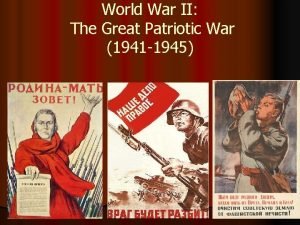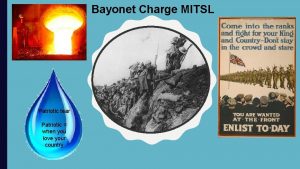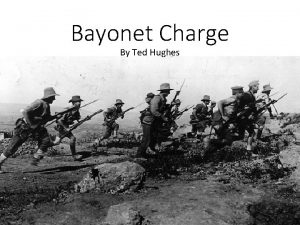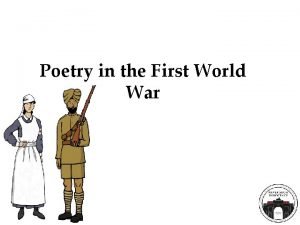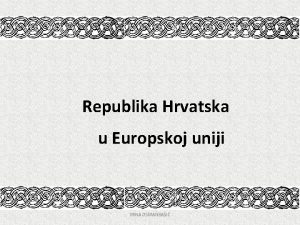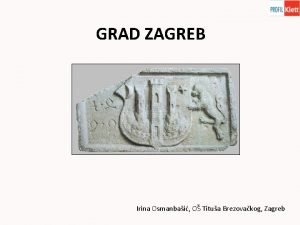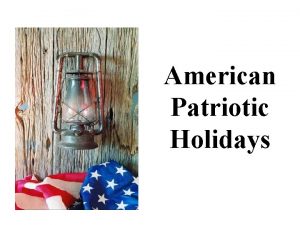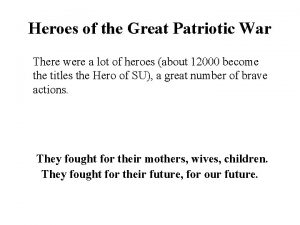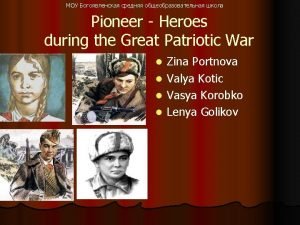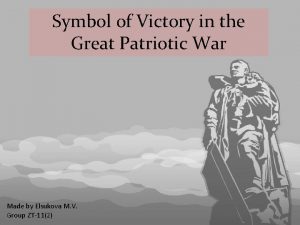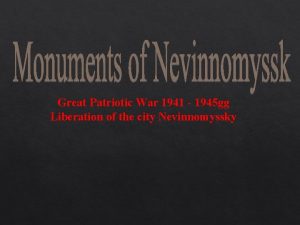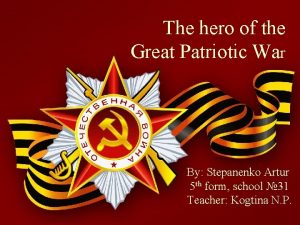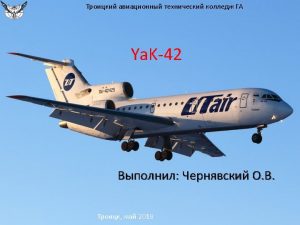The Great Patriotic War Irina Krivosheeva School 32















- Slides: 15

The Great Patriotic War Irina Krivosheeva School 32 Komsomolsk on Amur

The term Great Patriotic War is used in Russia and other former republics of the Soviet Union to describe the conflict fought during the period from 22 June 1941 to 9 May 1945 along the many fronts of the Eastern Front of World War II between the Soviet Union and Nazi Germany and its allies. The Nazi invasion of the USSR in June 1941 heralded the beginning of the most titanic battle in the history of humanity. The war ended in complete defeat for Nazi Germany less than four years later with the fall of Berlin on May 9, 1945. Over 20, 000 Soviet citizens and soldiers died in the struggle to liberate the Motherland from the fascist aggressors.

Before the War The Soviet Union signed a non-aggression pact with Nazi Germany on 23 August 1939. Moreover, there was a “Secret protocol” to the pact, revealed only after Germany’s defeat in 1945, according to which Romania, Poland, Lithuania, Latvia, Estonia and Finland were divided into German and Soviet “spheres of influence”.

Operation Barbarossa Operation Barbarossa, original name Operation Fritz, code name for the German invasion of the Soviet Union, which was launched on June 22, 1941. The failure of German troops to defeat Soviet forces in the campaign signaled a crucial turning point in the war.

The Siege of Leningrad’s horrific siege was one of the most lethal in world history. It lasted for 872 days, from September 1941 to January 1944. The city’s civilian population of almost three million refused to surrender, even though they were completely surrounded. By the first winter of the siege there was no heating, no water supply, almost no electricity and very little food. Despite non-stop air and little food. artillery bombardment, the city’s greatest enemies were hunger and bitter cold. Exhausted people collapsed and died. The streets were littered with dead bodies. The only life-line to the mainland was the ice of Lake Ladoga – known as the “Road of Life”.

The Siege of Leningrad The city survived, survived its heroic resistance summed up in the motto: “Troy fell, Rome fell, Leningrad did not fall”. The siege fall took the lives of at least 670, 000 people, although some estimates suggest that as many as 1. 5 million people died. The city became the symbol of Soviet resilience and invincibility. The siege was commemorated by the Green Belt of Glory, a unique complex of memorials along the historic frontline. You can still see warnings in St. Petersburg advising which side of the street is safe from the German shelling.

The Siege of Stalingrad One of the most brutal standoffs in human history had begun in the summer of 1942. A major industrial centre on the Volga River in southern Russia, Stalingrad (now Volgograd), was a coveted prize in itself. Control over it opened the way to the vital Caucasus oil fields. The horror of Stalingrad lasted for 199 days, costing an estimated 1. 5 million lives from both sides. The besieged city quickly turned into a meat grinder. The Soviet losses were so great that, at times, the life expectancy of a newly arrived soldier was less than a day. Areas captured by the Wehrmacht troops by day, were re-taken by the Soviet army at night. The Germans dubbed this type of war Rattenkrieg – “rat war”, bitterly joking about seizing the kitchen but still fighting for the living-room.

The Siege of Stalingrad One building that the Germans failed to take was the so-called “Pavlov’s House”. In “Pavlov’s House”. September 1942, a Soviet platoon led by Yakov Pavlov turned an apartment block in the city centre into an impenetrable fortress. Penned in and surrounded by Nazis, a little more than a dozen men rebuffed assault after assault. They held out for two months, until they were relieved by counter-attacking Soviet forces. Another Stalingrad legend was sniper Vasily Zaitsev. During the battles in and around the Zaitsev. city, he picked off more than 200 German soldiers. The Soviet press lost no time in spreading the news of his exceptional shooting skills. The story goes that the Germans decided to send a super-sniper of their own to kill him. After a dramatic cat-and-mouse game, lasting several days, Zaitsev finally outwitted his adversary. Although it doesn’t seem to be supported by either German or Soviet archives, the tale of the duel inspired the novel “War of the Rats” by David L. Robbins and a Hollywood epic “Enemy at the Gates”.

The Cost of Victory The Soviet troops held out against the enormous German army, decimating and wearing it out, until a relieving force encircled the city compelling the invaders to surrender. The crushing defeat at Stalingrad was unmatched in scale, spurring the Soviet drive towards victory… In May 1945 Berlin finally fell. The famous photo of two Soviet soldiers unfurling a red flag over the Reichstag became an iconic image of World War II It’s argued that the picture didn’t capture the actual moment of Soviet glory but was staged a day or two after the storming of the building, and even retouched by the Soviet propaganda machine. The flag is claimed to originally have been a tablecloth brought by the photographer himself. Still, this was a symbol of the USSR’s triumph… the victory that came at a colossal cost The number of Soviet deaths was at first grossly distorted – the figure Stalin gave in 1946 was seven million. The USSR’s losses are now estimated at about 26. 6 million, accounting for 26. 6 million half of all WW 2 casualties. The memory of the war, referred to as the Great Patriotic War, is particularly venerated in Russia. In the USSR the end of the war was considered to be May 9, 1945, when the German surrender took effect. The date has become a national holiday – Victory Day.

Heroes of the War Aleksei Maresyev When the Nazis invaded Russia in 1941, Maresuev was sent to the front to serve as a fighter pilot. By April 1942, Maresyev had shot down 4 German planes. However, on the 4 th April he was shot down and had to make an emergency landing. Badly injured, he crawled on his hands for eighteen days to reach the Russian frontlines. By that time, his legs had become badly frostbitten and had to be amputated. But Maresyev refused to give up. After a long and painful struggle he learnt how to fly with prosthetic legs. In 1943, he became a squadron leader. During one mission Maresyev shot down 3 enemy planes.

Zoya Kosmodemyanskaya Heroes of the War Kosmodemyanskaya joined the Komsomol in 1938. In October 1941, still a high school student in Moscow, she volunteered for a partisan unit. To her mother, who tried to dissuade her, she answered "What can I do when the enemy is so close? If they came here I would not be able to continue living. " Zoya was assigned to the partisan unit 9903. On November 27, 1941 Zoya received an assignment to burn the village of Petrischevo, where a German cavalry regiment was stationed. In Petrischevo, Zoya managed to set fire to horse stables and a couple of houses. However, one Russian villager had noticed her and informed the Germans. They caught Zoya as she started to torch another house. She was tortured and interrogated throughout the night but refused to give up any information. The following morning she was marched to the center of the town with a board around her neck bearing the inscription 'Houseburner' and hanged. Her final words were purported to be: "Hey, comrades! Why are you looking so sad? Be brave, fight, beat the Germans, burn, trample them! I'm not afraid to die, comrades. It is happiness to die for one's people!" and to the Germans, "You hang me now, but I'm not alone. There are two hundred million of us. You can't hang us all. They will avenge me. "

Heroes of the War The “Night Witches” The Soviet Union was the only country where woman could become fighter pilots. In 1941 Major Marina Raskova, a famous Soviet pilot, went to Stalin to convince him to set up three women’s fighter and bomber regiments. Stalin agreed and a special training center for women was set up in Engels. In a few months the women were taught what it takes most men four years to learn. The girls often flew old Po-2 planes known as “kukuruzniks” and men pilots often laughed at them. But the Germans feared them and called them the “night witches” because girls learnt to fly at night with their engines switched off and attack the enemy unexpectedly.

War Poetry Konstantin Simonov wrote this poem at the worst period of the war. The German army was 30 kilometers from Moskow, Leningrag was under siege, three million soldiers had been taken prisoner. The situation looked hopeless.

to Valentina Serova Wait for me, and I'll come back! Wait with all you've got! Wait, when dreary yellow rains Tell you, you should not. Wait when snow is falling fast, Wait when summer's hot, Wait when yesterdays are past, Others are forgot. Wait, when from that far-off place, Letters don't arrive. Wait, when those with whom you wait Doubt if I'm alive. Wait for me, and I'll come back! Wait in patience yet When they tell you off by heart That you should forget. Even when my dearest ones Say that I am lost, Even when my friends give up, Sit and count the cost, Drink a glass of bitter wine To the fallen friend Wait! And do not drink with them! Wait until the end! Wait for me and I'll come back, Dodging every fate! "What a bit of luck!" they'll say, Those that would not wait. They will never understand How amidst the strife, By your waiting for me, dear, You had saved my life. Only you and I will know How you got me through. Simply - you knew how to wait - No one else but you. 1941

Использованные источники • Журнал «Speak out» № 2, 2005. • http: //www. c 3 iopscenter. com/currentops/2016/08/23/23 -august 1939 -hitler-stalin-pact-nazi-soviet-non-aggression-pact-4/ • https: //en. wikipedia. org/wiki/Soviet_Union_in_World_War_II • https: //en. wikipedia. org/wiki/Non-aggression_pact • https: //wwiifrecker 11 k. wikispaces. com/Non-Aggression+Pact • https: //www. marxists. org/history/ussr/great-patriotic-war/ • http: //russiapedia. rt. com/russian-history/the-great-patriotic-war/
